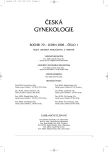Analysis of Present Diagnostic Methods of Intrapartal Fetal Hypoxia
Analýza současných diagnostických metod intrapartální hypoxie plodu
Cíl studie:
Zhodnotit specificitu současných diagnostických metod intrapartální hypoxie plodu (kardiotokografie – CTG, fetální pulzní oxymetrie – FpO2, ST-analýza EKG).
Typ studie:
Prospektivní studie.
Název a sídlo pracoviště:
Gynekologicko porodnická klinika 1. lékařské fakulty UK a Všeobecné fakultní nemocnice, Praha.
Metodika:
V období duben 2003–březen 2004 byly sledovány výsledky synchronního monitorování plodu pomocí CTG, FpO2 a STAN-ST 21 u 53 rodiček s rizikovým a patologickým porodem. Zjišťovali jsme, která z metod nejlépe předpověděla proběhlou intrapartální hypoxii plodu. Pro statistické vyhodnocení (p-znaménkový test a Mc Namarův test) jsme posuzovali, zda metoda předpověděla správně nebo špatně hodnoty skóre Apgarové v 1. minutě po porodu, pH z pupečníkové arterie, hodnotu laktátu. Dále byly sledovány výsledky tří metod při poporodní depresi, zkalené až kašovité plodové vodě a jak se jednotlivé metody uplatňovaly při indikaci k ukončení porodu.
Výsledky:
Ve srovnání s CTG byla statisticky významně vyšší specificita u FpO2 a STAN při hodnocení skóre Apgarové u novorozence v 1. minutě po porodu FpO2 (p=0,007) a STAN (p<0,001), při určení pH (a) z pupečníkové krve FpO2 (p=0,029) a STAN (p<0,001) a výskytu poporodní deprese novorozence ve 30.–60. minutách po porodu FpO2 (p=0,019) a STAN (p=0,0005). Změny v hladině laktátu z pupečníkové krve lépe predikoval STAN (p=0,001). FpO2 hodnotil změny stejně jako CTG. Hrozící hypoxii při silně zkalené až kašovité plodové vodě hodnotil správně pouze STAN (p=0,002). Hodnocení FpO2 nebylo statisticky významné. Mezi jednotlivými metodami nebyl zjištěn statisticky významný rozdíl v indikaci k operatičnímu ukončení porodu.
Závěr:
Výsledky jednoznačně ukazují, že použití dalších metod diagnostiky intrapartální hypoxie plodu – fetální pulzní oxymetrie a ST-analýzy EKG plodu – upřesňují tuto diagnostiku. Zavedení těchto metod vyžaduje správnou interpretaci a snahu porodníka využívat těchto metod v klinické praxi.
Klíčová slova:
kardiotokografie, fetální pulzní oxymetrie, ST-analýza EKG plodu, diagnostika intrapartální hypoxie plodu
Authors:
Z. Hájek 1; B. Srp 1; R. Haddad El 1; P. Drbohlav 1; A. Pařízek 1; K. Liška 1; A. Pašková 1; J. Zvárová 2; M. Šimečková 2
Authors‘ workplace:
Gynekologicko-porodnická klinika 1. LF UK a VFN, Praha, přednosta prof. MUDr. J. Živný, DrSc.
1; Akademie věd České republiky, EuroMise Praha
2
Published in:
Ceska Gynekol 2005; 70(1): 22-26
Category:
Original Article
Overview
Objective:
To evaluate specificity of present diagnostic methods of intrapartal fetal hypoxia (cardiotocography – CTG, fetal pulse oxymetry – FpO2, ST-ECG analysis).
Design:
A prospective study.
Setting:
Gynecology-Obstetrics Clinic, 1st Medical Faculty and General Faculty Hospital in Prague.
Methods:
The results of synchronic fetus monitoring by means of CTG, FpO2 and STAN-ST 21 were followed in 53 mothers with a risk and pathological delivering of birth in the period of April 2003 to March 2004. The study investigated, which of the methods provided the best prediction of the intrapartal fetal hypoxia. The statistical evaluation (p-mark test and Mc Namara test) was based on the assessment of correct or incorrect prediction of the Apgar score values in the first minute after birth, pH in umbilical artery and the lactate level. We also investigated results of three methods during postpartum depression, turbid or mushy amniotic fluid and the way the individual methods were made useful in indication for ending the delivery.
Results:
In comparison with CTG there was a statistically significantly higher specificity in FpO2 and STAN in the evaluation of Apgar score in the newborn in the first minute after birth, FpO2 (p=0.007) and STAN-ST (p<0.001), in the determination of pH (a) from umbilical blood FpO2 (p=0.029) and STAN (p=0.001) and the occurrence of postpartum depression of the newborn in minute 30–60 after birth FpO2 (p=0.019) and STAN (p=0.0005). The changes in lactate level in umbilical blood were better predicated by STAN (p=0.001). FpO2 evaluated the changes in the same way as CTG. The threatening hypoxia in strongly turbid or even mushy amniotic fluid was correctly evaluated by STAN only (p=0.002). The FpO2 evaluation was not statistically significant. There was no any statistically significant difference in the indication of operation for ending the delivery among the individual methods.
Conclusions:
The results univocally demonstrated that the used of other method for diagnosis on intrapartal fetus hypoxia – Fetal pulse oxymetry and ST – analysis of ECG of the fetus give more precision to the diagnosis. The introduction of these methods requires a correct interpretation and the effort of the obstetrician to use these methods in clinical practice.
Key words:
cardiotocography, fetal pulse oxymetry, ST-analysis of fetus ECG, diagnostics for intrapartal fetus hypoxia
Labels
Paediatric gynaecology Gynaecology and obstetrics Reproduction medicineArticle was published in
Czech Gynaecology

2005 Issue 1
Most read in this issue
- Abdominal hysterectomy – Risk Factor in Development of Urinary Incontinence? Results of a Questionnaire Study
- Risk Factors of the 3rd and 4th Degree Tear during Delivery
- Syndrome of Pseudomyxoma Peritonei – Description of Three Cases and Survey of the Problem
- Contribution of Doppler Examination in Pregnancy at Risk of Alloimune Fetus Anemia
